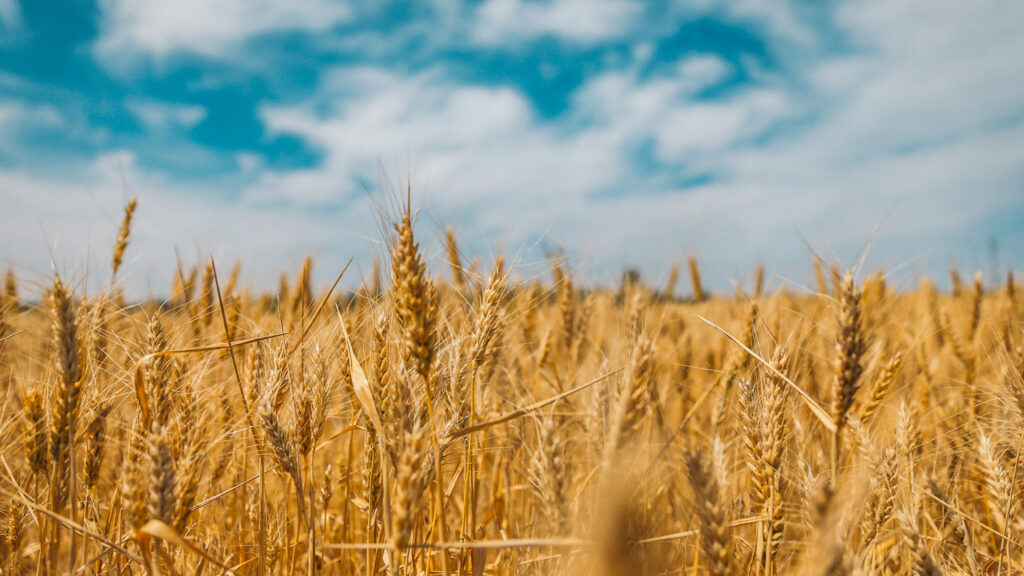Volcanoes are erupting in The Philippines, but on-fire Australia received some welcome rain. The Iran war cries have been called off and The Donald’s military powers are about to be hamstrung by the Senate. Meanwhile, his impeachment trial is starting, and we’re all on Twitter for a front-row seat.
Turning the tide on hunger
While the progress of the past century is of little comfort to those suffering food insecurity and hunger today, it is a powerful testament to what is possible in the future.

Emerging stones
“Wenn du mich seehst, dann weine”—“If you see me, weep.” This is an ominous German inscription carved in stone on the banks of the Elbe River in the Czech Republic. Inscribed into the rock at the base of the river in 1616, the inscription warns of drought-induced low water levels and the impending poor harvests, crippling food prices for what little remained, and inevitably, the hunger and death that was soon to follow. Such hunger stones have begun to surface again in Europe, as drought, possibly one of the worst in hundreds of years, has dramatically lowered the water level in rivers and lakes across the greater region. As the water levels recede, these hunger stones have begun to feature in headlines and social media posts globally. Scattered in the rivers throughout eastern Europe, these stones were inscribed over centuries, and recall many instances of drought and the catastrophic hunger and famine that followed.
A history of food insecurity
Historically, Europe has intermittently suffered the ravages of both drought and bouts of abnormally cold and wet weather, both leading to failed crop harvests, hunger, and occasionally famine. Across Europe and throughout pre-industrial history, harvest remained extremely low by modern standards. Traditional farming methods provided just enough food to meet the demand of a growing population, but no more. There simply wasn’t the surplus available in most European countries to sustain their populations through poor harvests induced by epidemic, war, drought, blight, or flood. Farmers, and those dependent on the literal and figurative fruits of their labor, were perpetually exposed to life on the knife edge of hunger at best and famine at worst.
Even by 1850, the organically fertilized and traditionally worked fields of Europe’s industrializing countries—England, Germany, and France—were turning out just 0.99 tonnes per hectare of wheat for England and Germany and 0.70 tonnes/ha for France. By contrast, all three countries, circa 2018, had wheat yields of between 6.6 and 7.7 tonnes/ha, a clearly non-trivial crop yield increase of 677 percent.
Turning the tide on hunger
What separated the low yields of Europe before the 20th century from the significantly higher yields of today, and the accompanying food surpluses those yields granted, were four great forces that reshaped the agricultural output of civilization. Starting first with German chemist Carl Bosch’s mastery of synthetic nitrogen fertilizer, and then followed by the massive gains of increasingly petroleum-fueled agricultural mechanization, production began to rise dramatically, first in the West and then gradually throughout the world. Then, in the early 1940s and extending through the 1960s, American agronomist Norman Borlaug pioneered and developed a number of high-yielding cereal grains and modern farming processes, which together kicked off the Green Revolution and helped save hundreds of millions from malnutrition and starvation.
The growth in agricultural yields didn’t stop in the 1960s. Rather, it was just beginning, as much of the world transitioned from net shortage to net surplus. Between 1961 and 2018, global cereal production grew from a little over 786 million metric tons to more than 3 billion, an increase of 281 percent. Over that same period, cereal production, a powerful indicator of farming efficiency, increased in North America, the European Union, and China by 183 percent, 133 percent, and 469 percent, respectively. Increased crop yields, in turn, lifted meat production, pushing the global production of meat up by 385 percent.
The additional food production—hard-won through agricultural innovation, powered by inexpensive energy, fed by unprecedented fertilizer supply, and moved and traded globally—lifted the global per capita kilocalorie supply from all foods per day from 2,164 kilocalories in 1961 to 2,939kcal in 2019. Increases in global food supplies of all kinds lifted life expectancy, decreased child mortality and undernourishment, and improved the quality of life for hundreds of millions. As undernourishment in developing countries fell from 34.7 percent in 1970 to just 13 percent in 2015, the global share of underweight children decreased in near lockstep, from 20 percent globally in 2000 to 12.6 percent by 2020.
Progress made but not completed
For a long time, it looked like humanity was on track to continue the unprecedented progress toward producing more food as well as getting it to market and to those requiring aid, ultimately reducing hunger, malnutrition, and the illness and death that result from both. Today, however, great challenges remain.
Historically, the three most destructive harbingers of food insecurity, hunger, and famine have been epidemic, climate change, and war. Today, the global food supply is being strained by those very same three destructive forces. Climate change, the ongoing global pandemic, and the Russian invasion of Ukraine all threaten to erode progress made in reducing hunger globally and push millions in low-income countries in Africa, Asia, and the Middle East into poverty, severe food insecurity, and famine. The share of the world’s population suffering from hunger has increased steadily from 8 percent in 2019 to 9.3 percent in 2020, and then to 9.8 percent in 2021. According to the World Health Organization (WHO), by the close of 2021, 828 million people were impacted by hunger, up roughly 46 million from the previous year and 150 million from 2019.
The global pandemic has disrupted critical international supply chains and food production, while inflation and high energy prices have wreaked havoc on the global economy. Higher energy costs globally and Russian sanctions have reduced both global production and trade, with Russian production of urea and DAP, both key fertilizers, accounting for 16 percent and 12 percent of global exports. The result has been an increase in fertilizer cost of 30 percent by May of 2022 and the lowest fertilizer affordability since the 2008 global food crisis. While fertilizer costs have fallen slightly since their peak, globally, they remain high and volatile, a condition that is expected to continue through 2023. The price spikes for fertilizer have impacted all three of the most widely used yield-boosting additives—fixed synthetic nitrogen, the use of which feeds half of the world’s population, as well as phosphorus and potassium. Together, the lingering economic and logistical pressures of the pandemic, climate change, and the war in Ukraine are testing the limits of the globalized food system.
However, while some are warning of the possibility of a full-scale collapse of the global food system, the window for adaptation, recovery, and renewed forward progress has not yet closed. While the current situation is certainly deeply concerning, hope remains that the worst can be averted over the next year.
A path forward
In the short to medium term, resuming exports of Ukrainian grain and other foodstuffs and freeing storage space in the Port of Odessa to receive incoming grain can help to alleviate some of the global shortfalls, as will an increased return of Russian grain to the market. A peaceful end to Russia’s medieval-style siege of Odessa, or at the very least ensuring the secure passage to market of Ukrainian agricultural exports, will help to ease pressure on an already strained global food system. At the same time, roughly 2.7 million tonnes of grain were safely exported thus far in 2022 under the Black Sea Grain Initiative. It is hoped that the agreement, brokered by Turkey and the United Nations, will help get both Ukrainian agricultural exports to the world, as well as Russian food exports and much-needed fertilizer, safely to market.
To mitigate growing food insecurity in middle- and low-income countries, governments globally will need to proactively invest in building a more resilient food system that can avert shortage before it happens. It will require lowering global political tensions; stabilizing inflation; reducing the cost of food, fertilizer, and energy; embracing and encouraging agricultural innovation and genetic engineering; improving yields and overall production; and bolstering international trade.
In particular, the role that agricultural genetic engineering can play in producing higher-yielding and more climate change-resilient crops has scarcely been exploited. In order for civilization to meet the world’s growing demand for food, humanity will need to undertake yet another Agricultural Revolution marked by climate adaptation. It will require farming productively and efficiently in a warmer and more environmentally volatile world.
The other significant and largely untapped opportunity for improving the future of global food stability is in reducing the likelihood of runaway pandemics and implementing swift and effective monitoring and mitigation when they do arise. The risk of a future pandemic that could gridlock civilization and cripple food supplies is still very real, and despite our recent experience with Covid-19, the global community remains underprepared for the next pandemic. Unintuitive as it may be, every dollar invested in reducing the risk exposure and the consequences of a catastrophic pandemic will strengthen the resilience of food systems to pandemic-induced shocks, both economic and logistical.
The current reversal in global food security and abundance marks a modest correction in the overall long-run trend of improving economic prosperity, food security, nutrition, and health. While the progress of the past century is of little comfort to those suffering food insecurity and hunger today, it is a powerful testament to what is possible in the future. Meeting and exceeding the global demand for food into 2050 will require doing more of what has worked thus far while at the same time driving forward without delay the agricultural innovations and tools required for future prosperity in a warming world.
The hunger stones exposed in the Elbe River and elsewhere are no longer a messenger of impending famine for Europe, but they are a reminder of the consequences of serious agricultural shortfalls and a window into a pre-industrial past where hunger was the norm rather than the exception. They are an opportunity to reflect on the agricultural progress of Europe and the world over the last 200 years and to plan a future where hunger and want are extinguished, not just in high-income countries, but everywhere.



[…] submitted by /u/tonymmorley [link] […]